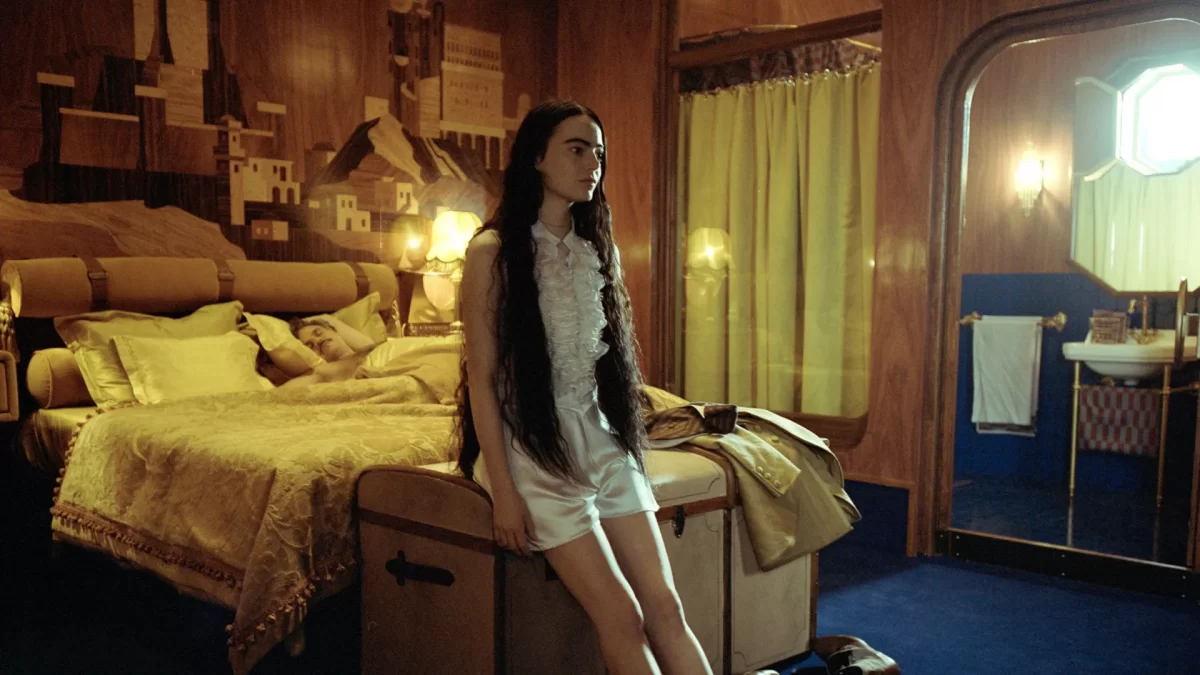By Edward Bayliss
When asked why he is so committed to his profession as a surgeon and scientific experimentalist, Dr. Godwin Baxter, or ‘God’, replies coolly: ‘My amusement.’ Physically disfigured and clinically disposed, Godwin Baxter (Willem Dafoe) bears all the hallmarks of a madly possessive psychopath as we see him rear his newest design, Bella Baxter (Emma Stone). Godwin’s literal brainchild (Bella’s brain is replaced with that of her unborn baby) is a young woman beginning to understand afresh the ways of the world. You’d be forgiven for thinking Godwin was a wicked and perverted man. It is however established early in the film that Bella was dead when Godwin performed his restoring surgery on her, and that Godwin is characterised more as a father figure than a Humbert Humbert of Lolita. He asks his creation, ‘Would you rather the world did not have Bella?’
Bella learns quickly; at first we see her stumbling across the black and white marbled floors with the awkwardness of a toddler, then, there comes her self-realisation and yearning for ‘experience’ and ‘adventure’. The main object of comedy in the film exists in the contention between Bella’s naïve outlook and her exposure to ‘the real world’ as she elopes with the seedy Duncan Wedderburn (Mark Ruffalo). For her, sex is ‘furious jumping’, food she dislikes is allowed to be spat out at high society dinners, and it is acceptable for her to ask Wedderburn in public if he would like to ‘tongue play’ her. Her physical comedy is also deftly crafted – she hasn’t yet mastered her own body, let alone her mind. It is hard to overstate the hilarity with which Bella’s character is met, accelerated also by Wedderburn’s growing frustration with her and his constant reprimands (‘You cunty cuntface dipshit’).
The two embark on a kind of odyssey, travelling to Lisbon, Alexandria, sailing across the Mediterranean, and eventually arriving in Paris. Lanthimos’ fantastic use of soundstages with painted glowing backdrops adds a surrealist slant to these settings in the film. These are especially striking as they are pitted against the black and white Victorian gothic look of London, with its strangely postmodern architecture and steampunk-inspired outfit. We move from the trivial treatment of gore and exacting empiricism in Godwin’s laboratory littered with nightmarishly Boschian animal hybrids, to the artistic and cultural wonders of the continent; the wide eyed Bella is arrested by such beauty. In tandem with Bella’s growing emotional awareness and intelligence, the camera becomes more excitable and adventurous. Its fisheye lens begins even more to distort and liven the frame, with increased use of wide angle tilt-shift shots (almost Luhrmann-inspired) that place small figures against fantastical set designs. Cinematographer Robbie Ryan clearly has had his fun, not at all at the expense of the film.
Bella encounters emotions unlike any she has felt before as she exclaims energetically, ‘my soul has been buckled’. Her mind becomes alive to ideas of politics and philosophy. Where once we might have considered her the ward, child, or sexual object of Wedderburn, she now intellectually outperforms him, and even prostitutes herself in Paris as an act of paradoxical sexual self-determination. At one moment in the brothel, Bella carries out vicious intercourse with a customer, at which point the camera shrewdly cuts to her reading a book entitled ‘Ethics’. She involves herself with socialist doctrine and vies for workers’ rights along with another prostitute colleague. Despite her means or methods, she is as the brothel manager asserts, ‘a woman plotting her course to freedom.’
Poor Things is, at its most basic form, a study. Occasionally, the camera will retreat into a circular frame and watch from a faraway wall, as though we are peering cautiously through an unadjusted microscope. This is a study that calls into question the critical notion of selfhood. Who is Bella Baxter? Is she the warped play-thing of Godwin? her unborn baby whose brain she possesses? or simply, her own evolving and learning creation? Moreso, Lanthimos makes it difficult for the viewer to discern who the real monsters, or ‘deformed’, are in his film. We meet so many characters who are debased, ugly, and despicable, but essentially human, that it leaves us wondering what exactly a ‘monster’ is.
My friend and I left Tyneside cinema with much to discuss – a train delay of over an hour gave us ample time to do so. I agreed with him when he said that it feels, upon watching Poor Things, like you have just read an entire book. That is how much this film offers.

